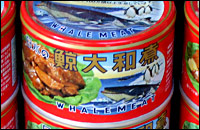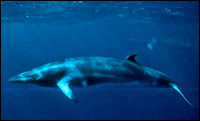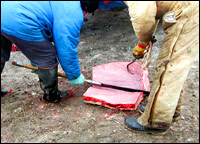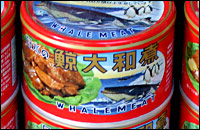If you’re into eating whales, Kouji Shingru’s shop is the place for you.
Located on a pedestrian-only street in Tokyo’s bustling Asakusa neighborhood, Shingru’s compact establishment has it all: deep red whale steaks and fillets in vacuum-sealed packages, cured whale on a stick, snack-sized bags of whale jerky, and a wide selection of canned whale morsels packed in brown sauce. A steady stream of customers — most of them over 50 — flows through the Yushi Special Shop in Whales, one of the capital’s only retail outlets for whale products.

Whale for sale in Shingru’s shop.
Photo: Colin Woodard.
“Almost all those who like whale meat are middle-aged and older,” says Shingru, a middle-aged man himself. “Young people have no experience with eating whale. In fact, my shop is one of the only places where young people have a chance to eat it.”
The problem, says Shingru, is with the supply. Since 1986, commercial whaling has been banned by the International Whaling Commission, and whale-eating nations have had to make do with the byproducts of their scientific catch. Japan — whose people once killed and ate thousands of blue, fin, sperm, sei, and humpback whales in a single season — has in recent years subsisted on an annual supply of 500 to 600 minke whales, each only a third the size of the fin whales that were once the backbone of the country’s whaling industry.
“Twenty years ago there was a lot of whale meat, and whale was a popular fish,” Shingru explains. “Now there is very little available, and whale meat is very expensive.” He holds up a 100-gram package of fresh minke bacon, white and light pink in color, selling for 1,800 yen ($15.30) — too dear for many consumers, he says. “Twenty years ago, this would have cost one-tenth as much.”
That may be about to change. This year Japan has more than doubled its whaling quota to 935 minkes, ostensibly as part of long-term research into the size and health of their population in the frigid waters around Antarctica. Norway has also boosted its quota in the North Atlantic, upsetting anti-whaling activists who note that this will be the world’s most deadly whaling season in a generation.
Indeed, 2006 could well be the year that the international whaling moratorium collapses altogether. In a triumph of patient diplomacy, Japan has used aid and trade measures to convince a small army of previously disinterested Caribbean and Pacific nations to join the IWC and vote with Japan. When the IWC meets this June in St. Kitts in the Caribbean, the pro-whaling bloc may well have the votes to overturn the ban. Whale, it seems, is back on the menu.
The Case for Whaling
Many in the West see a resumption of whaling as barbaric, a return to the dark days of the 20th century, when floating factories drove many great whales to the brink of extinction to procure industrial oil and pet food. But people in whale-eating nations see the issue differently, and find some of the criticisms by other countries hypocritical.
In Norway, even leading environmental groups like the Oslo-based Bellona Foundation support the country’s whale hunt. “We use small fishing vessels that consume few inputs and cause almost no pollution — it’s very friendly eco-production,” says Bellona’s Marius Holm. “Our principle is that we should harvest what nature provides, but in a sustainable way regarding the ecosystem as a whole and the specific stocks.” As long as it’s done sustainably, he adds, “We think whaling is a good thing.”

Make way for the minke.
Photo: NOAA.
Using those criteria, it’s hard to disagree. Norway’s government-sanctioned hunt is controversial — it’s the only country in the world that has a commercial hunt in defiance of the moratorium — but it does appear to be sustainable. Operating from about 30 small fishing vessels, Norway’s whalers are allowed to kill up to 1,052 minkes out of a total estimated North Atlantic population of roughly 100,000. “The hunt we have had along our coast has always been sustainable,” says Halvard Johansen of the Norwegian Ministry of Fisheries. “We’ve been whaling on this coast since the ninth century, and we don’t see that big a difference between aboriginal whaling and what we do here.” (Native residents in Alaska, Canada, Greenland, and St. Vincent and the Grenadines are permitted a limited annual subsistence hunt.)
“We utilize the whole animal — nothing is thrown away,” Icelandic whaler Kristjan Loftsson told me when I visited his country. Loftsson is managing director of Iceland’s four-boat whaling fleet, which catches about 40 minkes each year under a science permit. “We feel that we’re being hung for mistakes made 80 years ago in the Antarctic.”
Our interview started on the deck of one of Loftsson’s 150-foot steam-powered boats, which are so small they return from a hunt with one or two minke carcasses strapped to the outside of the hull. (The animals are butchered on shore.) But when my questions turned to the whale’s place in Icelandic food culture, Loftsson insisted we adjourn to 3 Frakkar, a nearby Reykjavik restaurant whose deep freezers have kept its tables supplied with whale throughout the moratorium.
The fin whale is served as sashimi, and looks and tastes like a cross between high-grade tuna and beef tenderloin. Despite spending 20 years in 3 Frakkar’s freezers, it’s subtle and delicious. “It’s the best sushi meat you can have,” Loftsson proclaims, his beard shaking with enthusiasm, “but here we eat it mostly as grilled meat.”
When the small dish is finished, I have some misgivings about having eaten part of a great whale, but the experience can’t fail to impress just how many meals a single whale must produce. In terms of food per life taken, it’s hard to compete with an 80-ton mammal — that’s 35,000 times the live weight of a chicken.
One’s Dear Old Taste
In Tokyo, Shingru had a back room where customers could eat their whale purchases, but I settled for a portable bag of minke whale jerky. It tasted something like beef jerky, only sweeter, as promised by the text on the package: “This Kuzira Jerky tastes sweet,” it read in English, “one’s dear old taste.”
The last reference was targeted at older Japanese who lived through the famine years at the close of World War II. In those days, whale meat provided a lifeline to a truly starving population, accounting for nearly half of all animal protein consumption, and earning itself a revered position in the nation’s food culture. “It is no exaggeration to say that the blood of the whale has flown in each Japanese person who has consumed whale as [an] important gift from the sea,” wrote Takeo Koizumi of the Tokyo University of Agriculture in a whaling association newsletter in 2003.
But a generation gap exists, says Hideki Moronuki, chief of the division that oversees whaling at the Japanese Fisheries Agency. “Whale meat is more than twice as expensive as yellowfin tuna, and many people, particularly the younger generation, can’t afford it,” he notes. “The quantity of whale meat provided by the market has increased because of the expansion of our research” — the meat from the additional whales captured for science must not be wasted, under IWC rules — “but still the price is not cheap.”
If the IWC moratorium is lifted, prices could go down — but demand, not supply, may become Japan’s problem. Even with an expanded scientific hunt, hundreds of tons of unsold whale meat have been piling up in storage freezers.

A native Alaskan crew at work.
Photo: NOAA.
Now there’s even a campaign to introduce whale to Japanese children and teens. Schools in Wakayama, a whaling region, have added the meat to their lunch program. “Whale culture” lessons have been added to elementary-school curricula, and one fast-food chain has started serving whale burgers, to a storm of international criticism.
But Glenn Inwood, a New Zealander who serves as spokesperson for Tokyo’s Institute for Cetacean Research, thinks the anti-whaling argument has become philosophical, not scientific. “It has really come down to whether or not you think the whale resource should be used at all, regardless of their abundance,” he says. Opposition, he says, is fueled by public revulsion over harpooning and flensing — the process of removing blubber from the carcass — two practices that opponents have videotaped for distribution.
In the end, supporters say the whale hunt is not all that different from the mainstream meat industry. “Many of us live in cities and eat meat wrapped in plastic and manage to have our eyes closed to where it came from,” Inwood says. “The one thing the meat industry has been successful at is making sure nobody sees what happens inside a slaughterhouse.”



